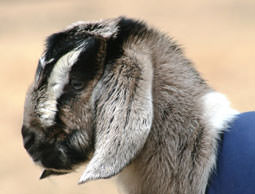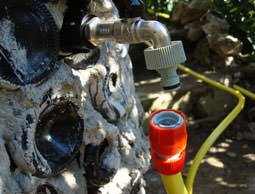
Photo by Cherie Langlois
My husband made a yummy, all-blue potato dish sprinkled with herbs and onions. |
Yikes, today is St. Patrick’s Day! That means:
A. I’ve got to find something green to wear. However, I’m not too worried about this, because green is my favorite color, so I’m bound to have something green to put on unless it’s buried in the dirty laundry. By the way, did you know that, according to Wikipedia, the color blue used to be associated with St. Patrick’s Day instead of green? That’s just weird.
B. I need to make sure we have all the fixin’s for our traditional St. Patrick’s Day supper of corned beef (one of the few times I eat beef during the year), homemade Irish soda bread, cabbage and potatoes.
C. Potatoes! That’s it! I’ve got to order my potatoes.
While I always save some seed potatoes from the previous year’s crop to replant, they never seem to produce quite as many potatoes as newly-ordered certified seed stock potatoes. Also, I like trying out a new “Heirloom” variety each year for the fun of it.
I buy my seed potatoes from Seed Savers Exchange, who send out their potato shipments until the end of April, but if you wait too long they sell out of their most popular varieties.
According to Seed Saver’s potato-planting guide, you can plant potatoes in the early spring whenever the ground can be worked, so I try to get them planted by the end of March or so.
Now the fun part: which new variety should I try this spring? Last year, we grew French Fingerlings, a potato with flushed-rose skin and creamy flesh that had the most wonderful flavor and melt-in-your-mouth texture when cooked—almost like it had been buttered already.
Sadly, we’ll be devouring the last of them in our St. Patty’s Day feast tonight, except for the off-limits bag of seed potatoes I saved. We’ve also grown Purple Viking, a pretty dusky-purple skinned potato with white flesh, and All Blue, which to me looks deep purple inside and out.
This year, the Seed Savers catalog offers me 15 potato varieties to choose from, including All Red, described as a red-skinned potato with pale pink flesh and a low starch content; Carola, a normal-looking brownish potato declared their most popular variety; and Caribe, another cool purple potato, but with snow-white flesh, that carries the admonition to PLEASE ORDER EARLY before they sell out.
By the way, if you’re a member, you can choose from a whopping 483 potato varieties!
I have a weak spot for purple potatoes, so right now I’m leaning toward Caribe—if they haven’t sold out already.
Happy St. Patrick’s Day!
~ Cherie
« More Country Discovery »












 Hobby Farms Presents®: Vegetable Gardens, Fall Edition™
Hobby Farms Presents®: Vegetable Gardens, Fall Edition™ Popular Gardening®: Vegetable Gardens, Spring Edition™
Popular Gardening®: Vegetable Gardens, Spring Edition™ Popular Gardening®: Tasty Tomatoes™
Popular Gardening®: Tasty Tomatoes™ Popular Gardening®: Vegetable Gardens™
Popular Gardening®: Vegetable Gardens™ Popular Gardening®: Orcharding®
Popular Gardening®: Orcharding® Popular Gardening®: Heirloom Farm® & Garden
Popular Gardening®: Heirloom Farm® & Garden Popular Gardening®: Organic Farm® & Garden
Popular Gardening®: Organic Farm® & Garden 
